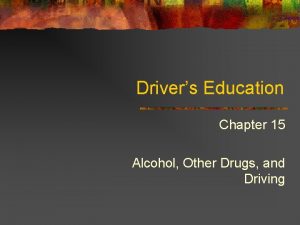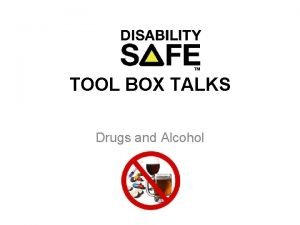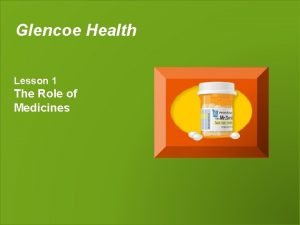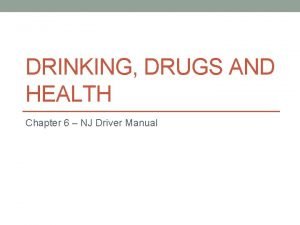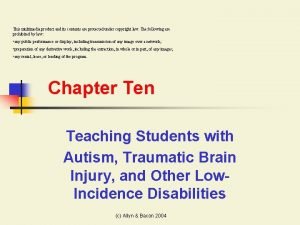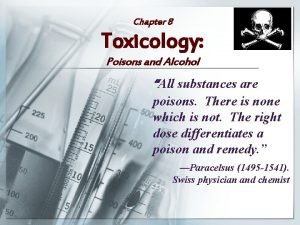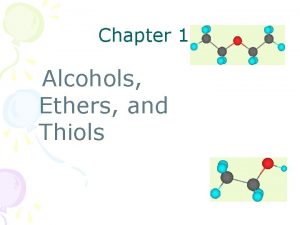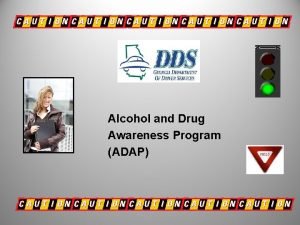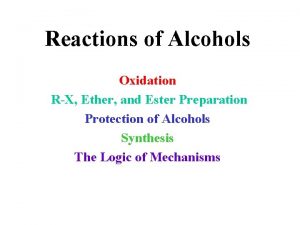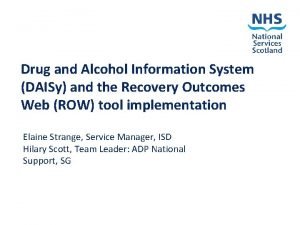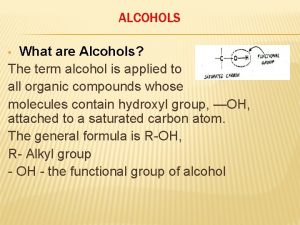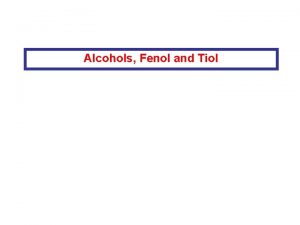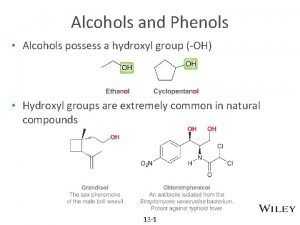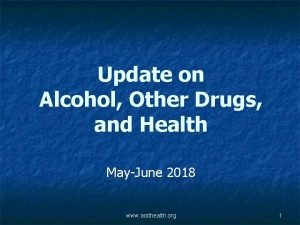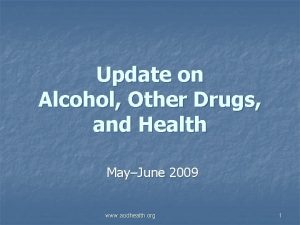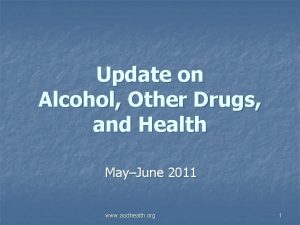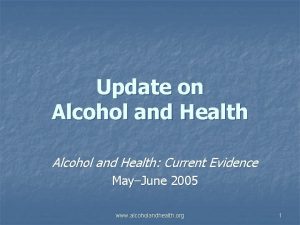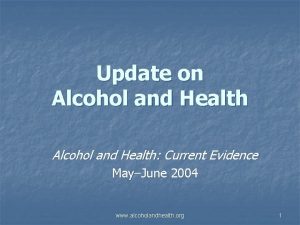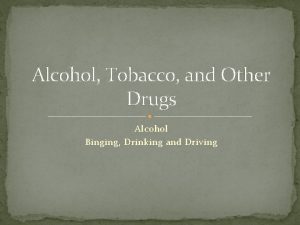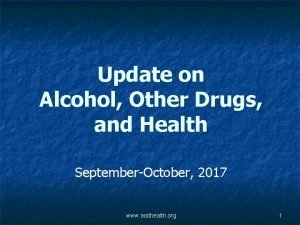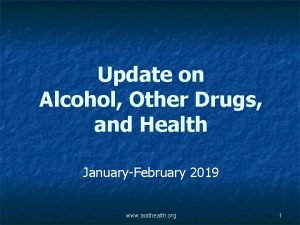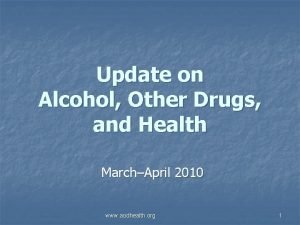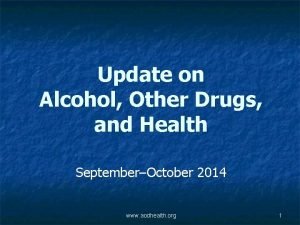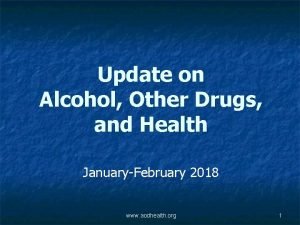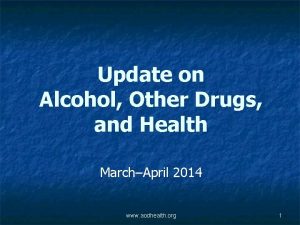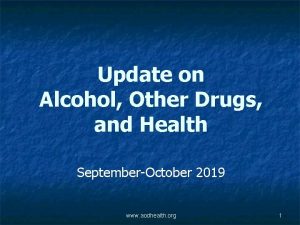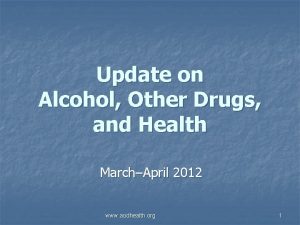Update on Alcohol Other Drugs and Health MayJune






















































- Slides: 54

Update on Alcohol, Other Drugs, and Health May-June, 2017 www. aodhealth. org 1

Studies on Interventions & Assessments www. aodhealth. org 2

No Effect Of An Extended Brief Intervention For People With Alcohol Use Disorder Owens L, et al. Alcohol. 2016; 51(5): 584– 592. Summary by Nicolas Bertholet, MD, MSc www. aodhealth. org 3

Objectives/Methods n n n In order to assess whether screening and brief intervention could have an effect on people with alcohol use disorder (AUD), this study tested an extended brief intervention delivered in an emergency department. Patients were screened using the AUDIT; those with scores >15 were randomized to receive either a face-to-face intervention with a trained nurse while at the hospital (n=79), or to usual clinical care (n=81), which entailed “advice on alternative treatment options” only. Participants in the intervention group could then receive up to 5 additional sessions at 1– 2 week intervals in an outpatient setting. www. aodhealth. org 4

Objectives/Methods, cntd. n n n Follow-up was at 3 and 6 months. The main outcome was reduction in DSM-IV alcohol dependence severity, measured with the Severity of Alcohol Dependence Questionnaire (SADQ) at 6 months. The mean number of sessions in the intervention group was 3 with a mean of 19. 6 minutes per session. www. aodhealth. org 5

Results n At 6 month follow-up: n n There was a reduction in both groups on the SADQ but no significant difference between groups (odds ratio, 1. 02). There were no differences between groups in regards to the secondary outcomes (AUDIT score, alcohol use, readiness to change [measured with the Readiness to Change Questionnaire], and Leeds Dependency Questionnaire score). www. aodhealth. org 6

Comments n n n Due to an imbalance between participants recruited before and after an internal pilot, the final analysis was restricted to participants recruited before the internal pilot. The study was therefore underpowered, but the measure of effect on the primary outcome suggests that the intervention was not superior to usual care. Clinically, treating AUD is important. Nevertheless, there is no evidence of efficacy for screening and brief intervention for patients with AUD over usual care. www. aodhealth. org 7

SBIRT Does Not Reduce Alcohol And Drug Use Among Jail Inmates Prendergast ML, et al. J Subst Abuse Treat. 2017; 74: 54– 64. Summary by Jeanette M. Tetrault, MD www. aodhealth. org 8

Objectives/Methods n n Around one half of incarcerated individuals meet criteria for a substance use disorder. Many others have used substances in amounts or ways that increase risk for health consequences. This study randomized 732 jail inmates within 4 weeks of release to screening, brief intervention, and referral to treatment (SBIRT), or screening and information on how to reduce their risk only (controls). www. aodhealth. org 9

Objectives/Methods, cntd. n n All participants received a baseline interview and were assessed using the Alcohol, Smoking, and Substance Involvement Screening Test (ASSIST). In the SBIRT group those with low or medium risk received a brief intervention in jail; participants at high risk were referred to community treatment following release and received the opportunity to participate in brief treatment (8 sessions). www. aodhealth. org 10

Results n n At baseline, 57% of participants did not have unhealthy alcohol use; 29% reported occasional or no drug use; and 40% reported high-risk amphetamine use. At 12 months, 28% (104 participants in the intervention arm and 100 participants in the control arm) were lost to follow-up. www. aodhealth. org 11

Results, cntd. n n Although there were some differences in baseline characteristics with regard to severity of alcohol and drug use, there were no differences in primary or secondary outcomes between the 2 groups after controlling for these differences. Over the 12 -month follow-up, few SBIRT and control participants reported attending inpatient treatment (15%) or outpatient treatment (9% versus 11%). In that time, 62% of SBIRT and 54% of control participants were rearrested. All comparisons were non-significant. www. aodhealth. org 12

Comments n n The results of this study are difficult to interpret since unhealthy substance use was not an entry criterion and the authors did not report the overall levels of substance use risk for participants. However, this randomized trial adds to the literature that SBIRT is not effective for reducing illicit drug use particularly when it is more severe, or for unhealthy alcohol use in patients with significant medical and psychosocial needs outside of general medical settings. www. aodhealth. org 13

TAPS: An All-In-One Screening Tool For Substance Use In Primary Care Mc. Neely J, et al. Ann Intern Med. 2016; 165: 690– 699. Summary by Kevin L. Kraemer, MD, MSc www. aodhealth. org 14

Objectives/Methods n n n Primary care providers are challenged with screening patients for multiple substances and assessing for substance use disorder, but current methods are cumbersome and timeconsuming. Researchers developed the Tobacco, Alcohol, Prescription medication, and other Substance use (TAPS) tool, comprised of a 4 -item initial screen and, if screen is positive for ≥ 1 substances, substance-specific follow-up assessment questions. The TAPS—either self or interviewer-administered—and reference standard Composite International Diagnostic Interview (CIDI) were completed in 2000 adult patients (mean age 46 years, 56% female, 12% Hispanic, 56% black) in 5 primary care clinics and compared. www. aodhealth. org 15

Results n Performance of interviewer-administered TAPS tool: Problem Use* Substance Tobacco Alcohol Prescription opioids Heroin Cocaine/metham phetamine Sedative Marijuana Substance Use Disorder** Sensitivity Specificity Past Year Use (%) 44. 1 62. 0 7. 4 Sensitivity Specificity 0. 93 0. 74 0. 71 0. 87 0. 79 0. 99 0. 74 0. 70 0. 48 0. 89 0. 85 1. 00 3. 9 8. 0 0. 78 0. 68 1. 00 0. 99 0. 66 0. 57 1. 00 0. 99 4. 1 20. 8 0. 63 0. 82 0. 99 0. 93 0. 54 0. 71 0. 99 0. 95 * Defined as meeting ≥ 1 CIDI criteria. ** Defined as meeting ≥ 2 CIDI criteria. n TAPS performance did not differ by mode of administration. www. aodhealth. org 16

Comments n n This is a well-done study in a diverse primary care population. The TAPS tool has reasonable performance characteristics, especially for problem use, but is less sensitive for the lowerprevalence substance use disorders. Although administration time of the interviewer-administered version is a potential limitation in busy primary care settings, the similar performance characteristics of the self-administered version is a strength. While it shows promise, I agree with the authors that the TAPS tool needs further refinement before broad implementation. www. aodhealth. org 17

Studies on Health Outcomes www. aodhealth. org 18

Alcohol and Cardiovascular Disease: Facts, Nuance, or Fallacy? Bell S, et al. BMJ. 2017; 356: j 909. Summary by Richard Saitz, MD, MPH www. aodhealth. org 19

Objectives/Methods n n n Recent methodologically sound studies find little evidence for the “J-shaped” curve suggesting low amounts of alcohol protect against death. Researchers in the UK examined electronic records for alcohol consumption among 1, 937, 360 patients age ≥ 30, and outcomes in 4 national databases. Analyses were adjusted for age, sex, smoking, and socioeconomic status. People with “moderate” consumption were the reference group. www. aodhealth. org 20

Results n n Cardiovascular disease (fatal and non-fatal) and mortality were lowest in the “moderate” group (e. g. , those described as consuming “alcohol within sensible limits” or as “light drinkers”); the hazard ratios (HR) for the non-drinking group (“teetotalers” or “non-drinkers”) were 1. 1 and 1. 2, respectively. For unstable angina, the only group that differed was nondrinkers (HR, 1. 3). For sudden death, former drinkers (HR, 1. 4) and people with heavy consumption (HR, 1. 5) were at risk; nondrinkers and people with “moderate” consumption were at similar risk. Non-drinkers and people with “moderate” consumption were at similar risk for subarachnoid and intracerebral hemorrhage. www. aodhealth. org 21

Comments n n n Doing the same studies over and getting the same result is not the same as finding the truth. The authors suggest that their study means the J-shaped curve is nuanced with some differences in associations for specific illnesses, but this study was no better at adjusting for confounders than many others. Non-drinkers and people with “moderate” consumption are so different (e. g. , in this study 31% versus 16% were socioeconomically deprived, respectively) that adjustment is inadequate. www. aodhealth. org 22

Comments, cntd. n n n Medical record review might not have reliably identified former drinkers, which would in such cases contaminate the non-drinker group, causing them to appear to be sicker. Excluding younger people selects for those who survived drinking or became former (sick) drinkers (the same conceptual mistake made in the >30 studies finding benefit for hormone replacement). This study did not report on cancer, which is known to be associated with “moderate” drinking. Alcohol exposure was based on what clinicians jotted down when they asked, not a valid method. The J-shaped curve may or may not be a fallacy, but this study fails to tell us whether consumption of low amounts of a carcinogen (alcohol) is protective or not. www. aodhealth. org 23

Aging, Alcohol Use, And Cognitive Impairment Sophocleous A, et al. Alcohol Clin Exp Res. 2016; 40: 2435– 2444. Summary by Kevin L. Kraemer, MD, MSc www. aodhealth. org 24

Objectives/Methods n n To compare neurocognitive consequences of alcohol use across age groups, researchers administered a comprehensive battery of neurocognitive tests to 66 adults (mean age 38. 5 years, age range 21– 69 years, 53% women, 70% white, 30% black) recruited for another study who were at high risk for HIV and hepatitis C infection but had neither. The battery covered domains of global cognition; speed of processing; and attention/executive, learning, memory, verbal, and motor function. Current alcohol use and lifetime DSM-IV alcohol dependence were measured using the Timeline Followback method and a structured clinical interview. The association of alcohol use with neurocognitive tests was compared across “younger” (<40 years) and “older” (>40 years) groups. www. aodhealth. org 25

Results n n n Twenty-one participants (32%) had current heavy* drinking and 35 (53%) had a lifetime history of alcohol dependence. Current heavy alcohol use was associated with significantly worse scores on global cognition, learning, memory, and motor function in older participants but not in younger participants. Lifetime history of alcohol dependence was associated with significantly worse scores on global cognition, learning, memory, motor, and attention/executive function, but the association did not differ across age groups. * Heavy alcohol use defined as: ≥ 5 drinks on one occasion and/or >14 drinks per week for men, and ≥ 4 drinks on one occasion and/or >7 drinks per week for women. www. aodhealth. org 26

Comments n n In this small cross-sectional sample, current heavy alcohol use was associated with worse neurocognitive scores in “older” adults, whereas lifetime history of alcohol dependence was associated with lower scores across all ages. Although the study’s small sample limited statistical adjustment for many confounders, the finding of greater impairment from current heavy alcohol use among older adults has certain face validity and supports current recommendations for lower-risk drinking limits. www. aodhealth. org 27

Even “Light” Alcohol Consumption In Adolescence Affects Grey Matter Volumes Heikkinen N, et al. Addiction. 2017; 112(4): 604– 613. Summary by Sharon Levy, MD, MPH www. aodhealth. org 28

Objectives/Methods n n Adolescents who drink alcohol are at increased risk for injury and substance use disorder later in life, even when they do not meet criteria for alcohol use disorder (AUD). This study assessed changes in grey matter volumes over a 10 -year period between adolescence and early adulthood in individuals who had alcohol use (as defined by AUDIT-C score), but did not meet criteria for AUD or use other substances. www. aodhealth. org 29

Results n The following areas had smaller grey matter volumes in participants with “heavy” drinking when compared with those with “light” consumption* (control): bilateral subgenual anterior cingulate cortex, right orbitofrontal and frontopolar cortex, right superior temporal gyrus, and the right insular cortex. * Defined by authors as: heavy = AUDIT-C score of ≥ 4 for males or ≥ 3 for females; light = AUDIT-C score of ≤ 2. www. aodhealth. org 30

Comments n n n This study demonstrates that even levels of alcohol consumption that may be considered benign “experimentation” during adolescence are associated with smaller grey matter in several brain regions. Functional changes in the insular cortex are associated with propensity to return to substance use; disrupted development in this area may be the basis of the association between early initiation and increased risk of AUD in adulthood. The results underscore the risks of adolescent alcohol use and suggest that AUD diagnostic criteria may not be sensitive enough to identify them in this population. www. aodhealth. org 31

The Association Of Alcohol Consumption With The Risk Of Dementia Xu W, et al. Eur J Epidemiol. 2017; 32: 31– 42. Summary by R. Curtis Ellison, MD www. aodhealth. org 32

Objectives/Methods n n n A number of epidemiologic studies have found that lower-risk alcohol intake may be associated with a decreased risk of developing dementia and/or cognitive decline, while heavy consumption may increase the risk. This meta-analysis was based on data from 11 studies with 4586 cases of all-cause dementia diagnosed among >70, 000 participants—plus 2 additional analyses of studies of approximately 50, 000 participants each—and evaluated the association of alcohol intake with the diagnosis of Alzheimer’s disease and vascular dementia. Seven studies provided results according to type of alcohol consumed, while 2 provided results according to APOE-4 levels. www. aodhealth. org 33

Results n n “Light-to-moderate” alcohol consumption* was associated with lower risk of all types of dementia (including vascular dementia and Alzheimer’s disease). There was a non-significant association with increased risk of dementia for consumers of >38 g alcohol/day (about 3– 4 typical drinks). Beverage-specific analyses indicated that the effect was only for wine, not for beer or spirits. For people with “moderate” wine consumption, the risk of dementia was reduced by ≥ 40% compared with non-drinkers. The presence or absence of APOE-4 did not appear to modify the risk. * Alcohol consumption was qualitatively defined as: light (<7 drinks/week), light-to-moderate (<14 drinks/week), moderate (7– 14 drinks/week), moderate-to-heavy (>7 drinks/week), and heavy (>14 drinks/week), with one drink = ~12 g alcohol. www. aodhealth. org 34

Comments n n The authors were unable to include the pattern of drinking and could not test for previous alcohol consumption among people currently without alcohol use. Overall, the results support a J-shaped curve between alcohol consumption and dementia, with effects primarily from wine. While mechanisms for such an effect are not well defined, in experimental studies both alcohol and polyphenols in wine have been shown to decrease atherosclerosis and favorably affect hematological factors (for cerebral as well as coronary arteries). Further, both alcohol and wine have been shown to have antiinflammatory effects and direct effects on brain structures that could relate to lower risk of dementia. www. aodhealth. org 35

Studies on HIV and HCV www. aodhealth. org 36

Enhanced MI May Reduce Non-Injection Drug Use Among Primary Care Patients With HIV and Low. Severity Substance Use Aharonovich E, et al. J Subst Abuse Treat. 2017; 74: 71– 79. Summary by Jeanette M. Tetrault, MD www. aodhealth. org 37

Objectives/Methods n n Non-injection drug use (NIDU) is common among people with HIV and can lead to poor health outcomes. Brief motivational interviewing (MI) provides a framework for HIV primary care clinicians to discuss reductions of NIDU with patients, but prior studies suggest that brief interventions alone do not result in reductions in use. www. aodhealth. org 38

Objectives/Methods, cntd. n n In this randomized trial, researchers investigated an enhancement to MI, Health. Call (HC), a tool that allows for daily patient self-monitoring calls to an interactive voice response (IVR) phone system with periodic personalized feedback. Participants (N=240) age ≥ 18 with ≥ 4 days of NIDU during the prior 30 days were assigned to: n n n control (n=83), MI-only (n=77; 30 -minute intervention with a trained counselor and 2 10– 15 minute booster sessions at 30 and 60 days), or MI + HC (n=80). www. aodhealth. org 39

Results n n n 16% of the sample met DSM-IV criteria for substance dependence; the primary drug of choice was crack for 50%; and the mean number of days of use in the 30 days prior to baseline was 8. Treatment retention at 60 days was: 89% (MI +HC), 82% (MI), and 78% (control) with no differences between the groups. Excellent rates of retention persisted at 12 months. At the end of treatment (60 days), there were no significant differences in decreases in the number of days of primary drug used or dollar amount spent on primary drug; however, at 6 and 12 months, both were lower in the MI group (incidence ratio for days 0. 49 and 0. 54, respectively at 6, and 0. 50 and 0. 45, respectively at 12 months) but not the MI + HC group compared with the control group. Unadjusted days of drug use decreased from approximately 8 -9 days at baseline (and $15) to 3 days (<$5) in the MI group, and to 4 days (and $7 -9) in the MI + HC and control groups. www. aodhealth. org 40

Comments n n n This study shows that among patients enrolled in primary HIV care who reported low-severity drug use, motivational interviewing (MI) groups, with or without phone-based selfmonitoring, and control groups all reported decreased drug use, with no differences between intervention and control at 60 days. Self-reported drug use was reduced at 6 and 12 months for those assigned to MI only but not to MI plus self-monitoring. Although MI is expected to have an effect, it is surprising that self-monitoring did not. Given multiple comparisons in this study, and prior large null randomized trials of brief intervention for drug use, these findings might be viewed as hypothesis generating and requiring replication. www. aodhealth. org 41

Hepatitis C Treatment Effective In An Opioid Treatment Program Butner JL, et al. J Subst Abuse Treat. 2017; 75: 49– 53. Summary by Darius A. Rastegar, MD www. aodhealth. org 42

Objectives/Methods n n n Hepatitis C virus (HCV) is the most common cause of chronic liver disease in the U. S. and the main risk factor is injection drug use. The development of direct-acting antiviral (DAA) treatments for HCV has improved the treatment of this condition. However, many patients do not have access to specialists to provide this treatment and there are concerns about its efficacy among individuals with substance use disorders. This report presents the outcomes of 75 patients who were treated with DAAs in an opioid treatment program. www. aodhealth. org 43

Results n n Of the 75 patients who initiated treatment, 10 were lost to follow-up and did not complete treatment. Among those who completed treatment, 98% achieved sustained virologic response – this was 85% of all those entering treatment. www. aodhealth. org 44

Comments n n n This study adds to growing evidence of the efficacy of DAAs for treatment of HCV in a variety of settings and patient populations. It also refutes the arbitrary limitations that some payers place on patients (e. g. , limiting treatment to those who are abstinent from alcohol and other drugs for at least 6 months) and clinicians (e. g. , limiting treatment to specialists). We need to do more to expand HCV treatment; providing it in opioid treatment programs is one way to accomplish this. www. aodhealth. org 45

Studies on Prescription Drugs and Pain www. aodhealth. org 46

Further Evidence of Associations Between Higher Prescribed Opioid Dose and Poor Chronic Pain Outcomes Morasco BJ, et al. J Pain. 2017; 18(4): 437– 445. Summary by Joseph Merrill, MD, MPH www. aodhealth. org 47

Objectives/Methods n n Higher opioid doses for chronic pain have been associated with multiple adverse outcomes compared with lower doses, including falls, fractures, and opioid overdose. Fewer data are available on patient-reported outcomes of chronic pain treatment. Researchers explored associations between long-term doses of prescribed opioids and patient-reported chronic pain outcomes. Data included electronic medical record (EMR) diagnoses and selfreport measures obtained at the baseline in-person visit of a prospective study of predictors and outcomes of opioid dose escalation. To allow for study of possible future dose escalation, patients with baseline daily doses >120 mg morphine equivalent dose (MED) were excluded. www. aodhealth. org 48

Results n n n 517 participants (including 186 veterans) with musculoskeletal pain diagnoses who were receiving stable doses of long-term opioid therapy were divided into 3 groups (low dose: 5– 20 mg MED, 38. 5% of patients; moderate dose: 20. 1– 50 mg MED, 36. 8%; higher dose: 50. 1– 120 mg MED, 24. 8%). Patients receiving higher-doses reported greater pain intensity, worse functioning and quality of life, poorer self-efficacy for managing pain, greater fear avoidance, and more health care utilization, compared with those in the low and moderate dose groups. Evidence for differences in mental health, depression, and alcohol and drug problems by opioid dose level was inconsistent across EMR and self-report measures. www. aodhealth. org 49

Comments n n n This study supports prior studies showing the association of higher prescribed opioid doses with poor chronic pain outcomes and extends those findings to include additional potential predictors of poor outcomes, including self-efficacy and fear avoidance. An observational study cannot determine whether higher doses play a causative role in poor outcomes or whether more severe problems led to higher doses. Sample selection strategies that excluded patients receiving the highest doses may partially explain the inconsistent associations between dose and mental health and addiction problems found in prior studies. www. aodhealth. org 50

Systematic Review: Alcohol Has Analgesic Effects Thompson T, et al. J Pain. 2016 [Epub ahead of print]. doi: 10. 1016/j. jpain. 2016. 11. 009. . Summary by Darius A. Rastegar, MD www. aodhealth. org 51

Objectives/Methods n n n Alcohol has been reported to reduce pain and some individuals with chronic pain report self-medicating with it. Researchers conducted a systematic review of controlled experimental studies examining the analgesic effects of alcohol on healthy individuals. They found 18 studies with a total of 404 participants meeting their criteria. www. aodhealth. org 52

Results n n A meta-analysis of the studies indicated that the administration of alcohol was associated with significantly increased pain threshold and reduced pain intensity. A meta-regression analysis of the association between alcohol concentration and analgesia found an increase in analgesia with higher blood-alcohol concentrations. www. aodhealth. org 53

Comments n n This study shows that alcohol has analgesic effects among healthy individuals who are exposed to painful stimuli. Whether this is also the case for people with habitual use or alcohol use disorder is unclear. Moreover, this study did not look at the effects of alcohol (if any) on chronic pain. In any case, the analgesic effects of alcohol may contribute to consumption among individuals with chronic pain; this is of particular concern since many of these individuals are also taking opioids for their pain and may be at increased risk for negative consequences. www. aodhealth. org 54
 What effect might alcohol and other drug
What effect might alcohol and other drug Chapter 15 alcohol other drugs and driving
Chapter 15 alcohol other drugs and driving Chapter 15 alcohol other drugs and driving
Chapter 15 alcohol other drugs and driving Alcohol and other drugs
Alcohol and other drugs Is an alternative of log based recovery.
Is an alternative of log based recovery. Drugs and alcohol toolbox talk
Drugs and alcohol toolbox talk Fors toolbox talks
Fors toolbox talks Formation of alcohols
Formation of alcohols Carboxylic acid to tertiary alcohol
Carboxylic acid to tertiary alcohol Chapter 19 medicines and drugs vocabulary practice answers
Chapter 19 medicines and drugs vocabulary practice answers Good host law nj
Good host law nj Alcohol bad for health
Alcohol bad for health Self-initiated other-repair examples
Self-initiated other-repair examples Product knowledge food and beverage service
Product knowledge food and beverage service Health and social care component 3
Health and social care component 3 Sql insert update delete query
Sql insert update delete query Data redundancy and update anomalies
Data redundancy and update anomalies Other health impairment definition
Other health impairment definition His bloody life in my bloody hands
His bloody life in my bloody hands Similarities between health education and health promotion
Similarities between health education and health promotion Chapter 3 health wellness and health disparities
Chapter 3 health wellness and health disparities Health education and propaganda
Health education and propaganda Chapter 1 lesson 2 what affects your health
Chapter 1 lesson 2 what affects your health Chapter 1 lesson 1 your total health
Chapter 1 lesson 1 your total health Arch drug and alcohol service
Arch drug and alcohol service Chapter 8 toxicology poisons and alcohol
Chapter 8 toxicology poisons and alcohol Chapter 8 toxicology test
Chapter 8 toxicology test Alcohol and anhydride reaction
Alcohol and anhydride reaction Upac
Upac Anhydride to amide
Anhydride to amide Esters smell
Esters smell Bryce often acts so daring
Bryce often acts so daring Advantages and disadvantages of alcohol thermometer
Advantages and disadvantages of alcohol thermometer Alcohol and drug awareness program (adap) certificate
Alcohol and drug awareness program (adap) certificate 12 core functions of addiction counseling
12 core functions of addiction counseling Drug and alcohol jeopardy
Drug and alcohol jeopardy Lucas reagent is
Lucas reagent is Drug and alcohol information system (daisy)
Drug and alcohol information system (daisy) Centre county drug and alcohol
Centre county drug and alcohol Structure and uses of cetosteryl alcohol
Structure and uses of cetosteryl alcohol Alcohol and hbr
Alcohol and hbr Oh group in phenol is
Oh group in phenol is Indiana retail merchant certificate renewal
Indiana retail merchant certificate renewal Drug and alcohol safety training
Drug and alcohol safety training Zechariah
Zechariah Zechariah 2:8-9
Zechariah 2:8-9 University community plan
University community plan Temporary update problem in dbms
Temporary update problem in dbms Www.com sab update.com
Www.com sab update.com Routing area update
Routing area update Dokumen deskripsi sdmk
Dokumen deskripsi sdmk Gtcs prd examples
Gtcs prd examples Position update formula
Position update formula Position update formula
Position update formula Fiberhome software download
Fiberhome software download

